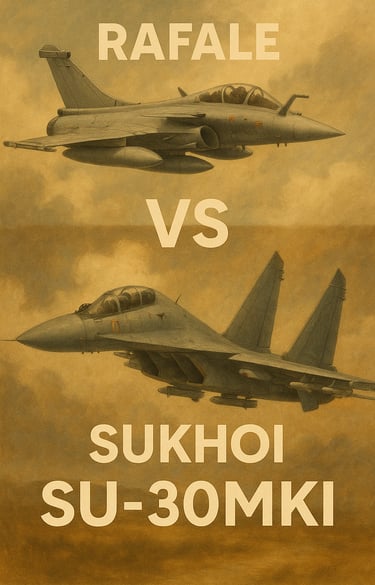Rafale vs Sukhoi Su-30MKI: Who Rules the Sky?
When the sky becomes the battlefield, it’s not just about flying — it’s about dominance.
ARTICLE
🛩️ Rafale: The Precision Predator
The Dassault Rafale, inducted into the Indian Air Force in 2020, represents a new era of precision warfare.
Designed as an omnirole fighter, the Rafale excels in air-to-air, air-to-ground, and reconnaissance missions.
Armed with advanced weapons like the Meteor (Beyond Visual Range missile) and SCALP cruise missiles, it can strike deep inside enemy territory without being seen.
Its SPECTRA electronic warfare suite makes it nearly invisible to radar and highly survivable in hostile environments.
With a sleek design, AESA radar, high combat radius, and top-tier agility, the Rafale is built for surgical, first-strike dominance — making it a silent, high-tech assassin in India’s aerial arsenal.


🛡️ Su-30MKI: The Heavy-Hitting Workhorse
The Sukhoi Su-30MKI, co-developed with Russia and manufactured by HAL, has been the backbone of the Indian Air Force since 2002.
A true multirole heavyweight, the Su-30MKI is known for its super-manoeuvrability, large payload capacity, and long endurance.
It can carry a wide array of Indian and Russian weaponry — including the BrahMos-A, the world's fastest cruise missile launched from the air.
With twin engines, thrust vectoring, and robust radar systems, it’s tailor-made for dogfights, strike missions, and air dominance roles.
More than just a fighter, the Su-30MKI is a flying war machine — rugged, reliable, and deeply integrated into India’s defence infrastructure.
When it comes to defending India’s airspace, there’s no single ruler of the skies — because Rafale and Su-30MKI complement each other, not compete. The Rafale delivers precision, stealth, and electronic warfare supremacy, ideal for first-strike and deep-penetration missions. The Su-30MKI brings raw power, agility, and payload strength, making it perfect for air superiority and long-duration patrols. Together, they form a deadly air power duo — one built for finesse, the other for force. In the evolving theatre of modern warfare, it’s not about choosing one jet over the other. It’s about combining their strengths to create an unmatched aerial advantage for India.
With Rafale’s scalpel and Sukhoi’s hammer, the Indian Air Force is ready for any battle — from the shadows or in the skies.


